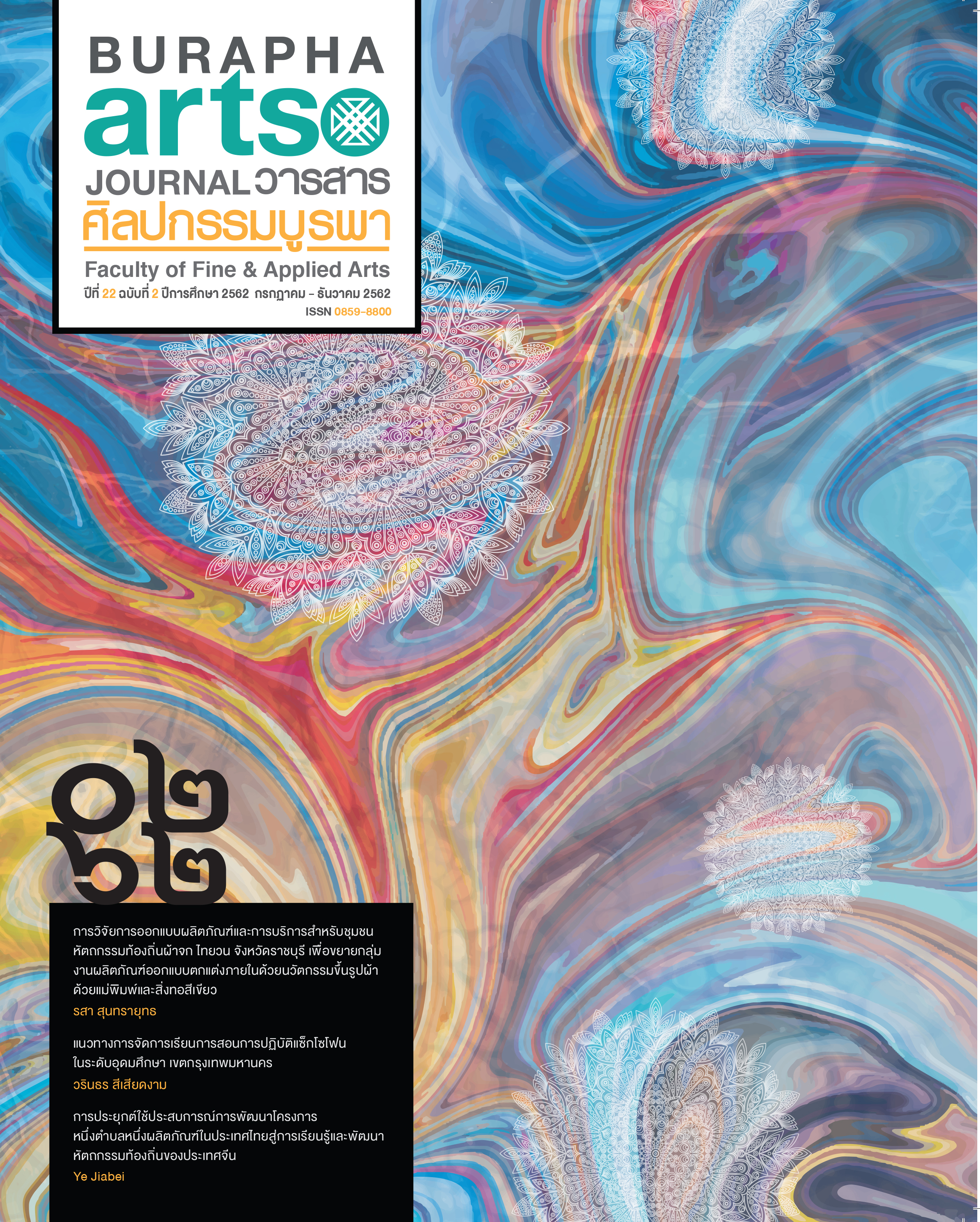การประยุกต์ใช้ประสบการณ์การพัฒนาโครงการหนึ่งตำบลหนึ่งผลิตภัณฑ์ ในประเทศไทยสู่การ เรียนรู้และพัฒนาหัตถกรรมท้องถิ่นของประเทศจีน
Main Article Content
บทคัดย่อ
จากแนวทางหลกั ทฤษฎเีศรษฐกจิ พอเพยี งของพระบาทสมเดจ็ พระเจา้ อยหู่ วั ภมู พิ ลอดลุ ยเดช ซึ่งมีความส�าคัญในการผลักดันและพัฒนาโครงการ “หนึ่งต�าบลหนึ่งผลิตภัณฑ์”(OTOP) ใน ประเทศไทย ด้วยหลักการจากผลการปฏิบัติงานและประสบการณ์อันเป็นประโยชน์ ท�าให้เกิด แนวคิดและวิถีทางในการอนุรักษ์และพัฒนางานศิลปหัตถกรรมในประเทศไทยมากมาย ดังนั้นจึง ควรค่าแก่การศึกษาเพื่อน�ามาเป็นแบบอย่าง รวมทั้งเพื่อเรียนรู้ข้อดีต่าง ๆ โดยบทความนี้จึงเป็นการ วิเคราะห์จากการศึกษาเปรียบเทียบนโยบายและการพัฒนาศิลปหัตถกรรมท้องถิ่นในประเทศจีน และไทย โดยใช้โครงการ OTOP เป็นกรณีศึกษา ซึ่งประมวลแนวคิดสรุปจากประสบการณ์ในการ ศึกษาข้อมูลศิลปหัตถกรรมท้องถิ่นของไทยเพื่อน�าไปสู่ข้อเสนอแนะวิธีการอนุรักษ์และวิธีการพัฒนา อย่างก้าวกระโดดให้กับศิลปะหัตถกรรมท้องถิ่นของจีน
Article Details

อนุญาตภายใต้เงื่อนไข Creative Commons Attribution-NonCommercial-NoDerivatives 4.0 International License.
ต้นฉบับที่ได้รับการตีพิมพ์ในวารสารศิลปกรรมบูรพา (Burapha Arts Journal) คณะศิลปกรรมศาสตร์ มหาวิทยาลัยบูรพา ถือเป็นกรรมสิทธิ์ของมหาวิทยาลัยบูรพา ห้ามนำข้อความทั้งหมดหรือบางส่วนไปพิมพ์ซ้ำเว้นเสียแต่ว่าจะได้รับอนุญาตจากมหาวิทยาลัยฯ เป็นลายลักษณ์อักษร
เอกสารอ้างอิง
วารสาร Abraham Gert Van Der Vyver . (2014). Bolstering the Thai OTOP Model for Economic Development with the Social Media. International Journal of the Computer, the Internet and Management, 2014. 5-8 (22-2). Kaoru NATSUDA, Kunio IGUSA. (2011). One Village One Product - Rural Development Strategy in Asia: the Case of OTOP in Thailand. RCAPS Working Paper, 2011.8. Igusa, Kunio. (2008). The Problem of the Regional Revitalization in Asia and One Village One Product-Adaptability of Oita Model to Asian Countries. Journal of OVOP Policy Vol. lOctober 2008. Vipada Sitabutr, Paitoon Pimdee. (2017). Thai Entrepreneur and Community-Based Enter prises’ OTOP Branded Handicraft Export Performance: A SEM Analysis. SAGE Open 7(1). Wang Hongxia. (2019). Rural Ageing and Rural Spatial Evolution:Spatial Developments in Ageing of Rural China at Township Level. Population Research, 43(5), 66-80. Zhao Wei, Chen Jun. (2007). An investigation and Enlightenment on the movement of “one village, one product” in Japan. Hubei Agricultural Sciences, 2007.9 (5).
วิทยานิพนธ์ Liu Deping. (2013). A comparative study on the geographical pattern and public policy of “One Village, One Product” between China, Japan and Thailand. Human cultural geography, Master’s thesis, Central China Normal University. Zou Qinyuan. (2014). Study on the development of “one village, one product” of rural handicraft in Thailand and Yunnan. Ethnic minorities’ cultural industry, Master’s thesis, Yunnan University.
เว็บไซต์ Ke Yueying, Ye Fenglin. (2019). 2019 China rural products and craftsman catalog. Retrieved 22 Macrh 2020. https://new.qq.com/omn/20191224/20191224A0TODB00 Tourism Authority of Thailand. What is OTOP?. Retrieved 22 Macrh 2020. https://www.thaiembassy.sg/friends-of-thailand/p/what-is-otop


